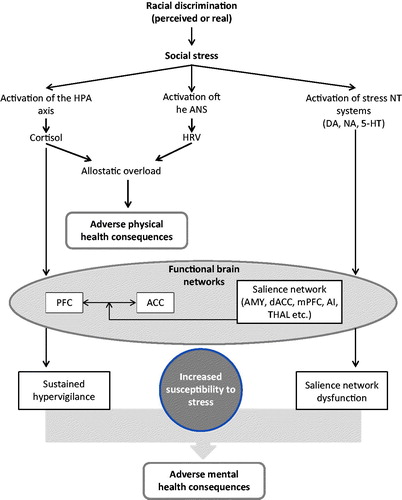Figures & data
Table 1. Summary of the effects of racial discrimination on the activation of the HPA axis.
Table 2. Summary of functional brain imaging studies on the effects of discrimination and social exclusion.
Figure 1. A working model of how racial discrimination may result in adverse mental health consequences. Briefly, racial discrimination is perceived as a form of social stress, leading to the activation of the HPA axis, the ANS and stress-related neurotransmitters in the brain. Sustained elevation of cortisol over time leads to allostatic overload, which, together with altered HRV, a measure of the abnormal activation of ANS, may contribute to adverse physical health consequences. Functional brain networks encompassing the PFC, ACC and the salience network receive hormonal inputs, cortisol, from the periphery and neurotransmitter innervation from lower, subcortical regions. Glucocorticoid-driven structural changes within these networks and altered network activity due to abnormal afferent neurotransmitter inputs may contribute in deleterious functions consequences, such as sustained hypervigilance and abnormal salience attribution, which, in turn, can result in increased susceptibility to everyday stressors, including discrimination. These together may contribute in the development of adverse mental health consequences associated with racial discrimination, including, anxiety disorders, depression and psychosis. See further details in the text. Abbreviations: 5-HT: 5-hydroxy-tryptamine, serotonin; ACC: anterior cingulate cortex; AI: anterior insula; AMY: amygdala; ANS: autonomic nervous system; DA: dopamine; dACC: dorsal anterior cingulate cortex; HPA: hypothalamic-pituitary-adrenal; mPRC: medial prefrontal cortex; NA: noradrenaline; NT: neurotransmitter; PFC: prefrontal cortex; THAL: thalamus.


